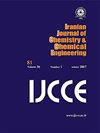工程藻类生物炭对水溶液中Cu2+的吸附
IF 1.3
4区 工程技术
Q4 CHEMISTRY, MULTIDISCIPLINARY
Iranian Journal of Chemistry & Chemical Engineering-international English Edition
Pub Date : 2021-06-14
DOI:10.30492/IJCCE.2021.128639.4169
引用次数: 0
摘要
由于污染程度高和水处理费用高,在低收入国家提供安全饮用水存在问题。虽然现有的水处理方法在去除大多数污染物方面是有效的,但它们是昂贵的。考虑到制造吸附剂的原料很容易获得,并且易于生产,吸附法可能是一种更便宜和有效的替代方法。本研究的目的是通过间歇式实验和固定床柱法合成藻类吸附剂,并评价其去除废水中Cu2+的性能。藻类生物质在限氧条件下热解生成生物炭(BC),分别使用:(1)氯化铁生成Fe2O3-BC复合物,(2)KMnO4和H2SO4通过改进的Hummer方法生成HBC。批试验数据拟一阶(r2=0.965)和拟二阶(r2=0.946)动力学模型拟合良好,差异无统计学意义(p=0.349)。Yoon-Nelson (r2=0.879)和Thomas (r2=0.891)模型充分描述了实验数据,而Adams-Bohart模型在列研究中拟合度较低(r2=0.673)。结果表明,生物吸附剂对废水中的Cu2+有较好的去除效果,其中HBC对Cu2+的亲和力高于Fe2O3-BC和BC。吸附后的FTIR测量表明羰基在Cu2+离子的结合中起关键作用。总的来说,增加藻类生物量可能有助于解决藻华问题,同时为水处理提供材料。进一步的研究应探讨经济可行性和扩大规模的技术,以现场规模。本文章由计算机程序翻译,如有差异,请以英文原文为准。
Engineered Algal Biochar for the Sequestration of Cu2+ from Aqueous Solution
The provision of safe drinking water in low-income countries is problematic due to high levels of pollution and high cost of water treatment. While existing water treatment methods are efficient in removing most contaminants, they are expensive. Adsorption methods may be a cheaper and efficient alternative, given that feedstock for the fabrication of adsorbents are readily available, and they are easy to produce. The objective of this study was to synthesize and evaluate the performance of algae-derived adsorbents in removing Cu2+ form wastewater using batch experiments and fixed-bed columns. Algal biomass was pyrolyzed under limited oxygen to produce biochar (BC), which was separately activated using: (1) ferric chloride to form a Fe2O3-BC composite, and (2) KMnO4 and H2SO4 through a modified Hummer’s method to form HBC. Batch experimental data fitted well in both pseudo-first order (r2=0.965) and pseudo-second order (r2=0.946) kinetic models, and there was no significant difference (p=0.349). The Yoon-Nelson (r2=0.879) and Thomas (r2=0.891) models adequately described the experimental data, while the Adams-Bohart model had low fit (r2=0.673) in column studies. The results showed that the biosorbents were effective in removing Cu2+ from wastewater, with HBC having a higher affinity than Fe2O3-BC and BC. FTIR measurements after adsorption suggest that carbonyl groups played a key role in binding Cu2+ ions. Overall, valorizing algal biomass potentially helps towards solving the problem of algal blooms, while providing material for treating water. Further research should investigate the economic feasibility and up-scaling of the technology to field-scale.
求助全文
通过发布文献求助,成功后即可免费获取论文全文。
去求助
来源期刊

Iranian Journal of Chemistry & Chemical Engineering-international English Edition
CHEMISTRY, MULTIDISCIPLINARY-ENGINEERING, CHEMICAL
CiteScore
2.80
自引率
22.20%
发文量
0
审稿时长
6-12 weeks
期刊介绍:
The aim of the Iranian Journal of Chemistry and Chemical Engineering is to foster the growth of educational, scientific and Industrial Research activities among chemists and chemical engineers and to provide a medium for mutual communication and relations between Iranian academia and the industry on the one hand, and the world the scientific community on the other.
 求助内容:
求助内容: 应助结果提醒方式:
应助结果提醒方式:


